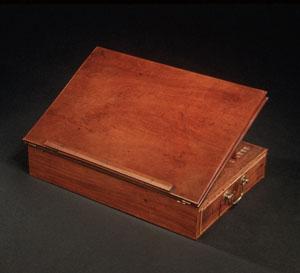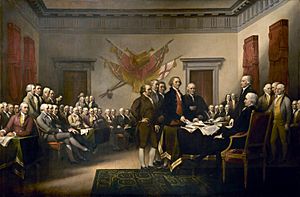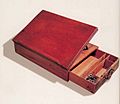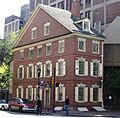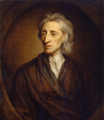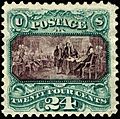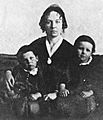United States Declaration of Independence facts for kids
Quick facts for kids United States Declaration of Independence |
|
 1823 facsimile of the engrossed copy
|
|
| Created | June–July 1776 |
| Ratified | July 4, 1776 |
| Location | Engrossed copy: National Archives Rough draft: Library of Congress |
| Authors | Thomas Jefferson et al. (Engrosser: Possibly Timothy Matlack) |
| Signers | 56 delegates to the Continental Congress |
| Purpose | To announce and explain separation from Great Britain |
The United States Declaration of Independence is a super important paper in American history. It was officially agreed upon on July 4, 1776. This document announced that the American colonies were no longer controlled by Great Britain. Instead, the thirteen British colonies decided to become a new country of free and independent states.
Contents
Why the Declaration Was Needed
Before 1776, the United States of America was not a country. The individual states were colonies of the British Empire. This meant that the King and the British Parliament ruled these colonies.
What Made Americans Unhappy?
Many American people were angry at Great Britain. They did not like paying taxes to Great Britain. They felt it was unfair because they had no one to speak for them in the British Parliament. Americans wanted the same rights as people living in Great Britain if they were going to pay the same taxes.
How the Colonies Took Action
Because of Great Britain's actions, like the Intolerable Acts, the different colonies formed a group called the Continental Congress. This group met in Philadelphia to make decisions for all the colonies.
During a meeting of the Second Continental Congress on June 11, 1776, they chose five people to write a document. This document would become the Declaration of Independence. The people chosen were:
- John Adams, from the Massachusetts Bay Colony
- Benjamin Franklin, from the Province of Pennsylvania
- Thomas Jefferson, from the Virginia Colony
- Robert R. Livingston, from the Province of New York
- Roger Sherman, from the Connecticut Colony
Writing the Declaration of Independence
Who Wrote the Declaration?
The committee decided that one person would write the document. The others would give him ideas and advice. John Adams suggested that Thomas Jefferson should write it. Adams told Jefferson he was the best writer and from Virginia, which was important. So, Jefferson started writing.
What Does the Declaration Say?
In the Declaration, Jefferson first wrote about people's rights. He explained what a government should and should not do. This part is called the Preamble.
Then, he listed specific bad things the British government had done to the colonies. He said these included putting people in jail without good reason, making taxes too high, and not respecting the people in the colonies.
When Was the Declaration Approved?
On July 2, 1776, the Continental Congress discussed the Declaration and made some changes. After making changes, they approved it. They declared their independence from the British Empire that day at the Pennsylvania State House.
However, the Continental Congress did not officially approve the final printed Declaration until July 4. On that day, twelve of the thirteen colonies' groups approved it and ordered it to be printed. The group from the Province of New York did not vote at that time. This first printed version was signed only by John Hancock, who was the President of the Congress.
On July 15, the New York group finally agreed with the others. This meant everyone in the Congress agreed on the Declaration.
On July 19, the Declaration's title was changed to "the unanimous declaration of the thirteen United States of America."
Overall, 56 men signed the Declaration. However, they did not all sign at the same time. Many signed a special parchment paper copy on August 2. Some signers were not even there when the Declaration was first approved on July 4. One signer, Matthew Thornton, signed on November 4, 1776.
What Happened After the Declaration?
The Declaration of Independence had many important effects.
Effects on Great Britain
When King George III and the British Parliament heard about the Declaration, they were very angry. Great Britain and the American colonies were already fighting in a war called the American Revolution. America won this war. In 1783, Great Britain had to accept the independence of the new country, the United States, in a peace agreement called the Treaty of Paris.
Effects on America
The Declaration of Independence also talks about the simple ideas that the people who started the United States believed in. It says that every person in the U.S. has the right to life, liberty, and the pursuit of happiness. It also says that the government must listen to its own people. These ideas helped make America a free and independent country.
Americans know that the Declaration of Independence is very important. Every year on July 4, they have a holiday called Independence Day. They celebrate this holiday to remember the day the Declaration was approved. It's the day the United States of America officially became its own country. People often celebrate with parades, fireworks, and songs.
Important Parts of the Declaration
The Starting Text
The first part of the Declaration explains that if a group of people needs to separate from another, they should explain why. It says:
When in the Course of human events, it becomes necessary for one people to dissolve the political bands which have connected them with another, and to assume among the powers of the earth, the separate and equal station to which the Laws of Nature and of Nature's God entitle them, a decent respect to the opinions of mankind requires that they should declare the causes which impel them to the separation.
The Preamble
The preamble is the most famous part of the Declaration. It says:
We hold these truths to be self-evident, that all men are created equal, that they are endowed by their Creator with certain unalienable Rights, that among these are Life, Liberty and the pursuit of Happiness. — That to secure these rights, Governments are instituted among Men, deriving their just powers from the consent of the governed, — That whenever any Form of Government becomes destructive of these ends, it is the Right of the People to alter or to abolish it, and to institute new Government, laying its foundation on such principles and organizing its powers in such form, as to them shall seem most likely to effect their Safety and Happiness. Prudence, indeed, will dictate that Governments long established should not be changed for light and transient causes; and accordingly all experience hath shewn that mankind are more disposed to suffer, while evils are sufferable than to right themselves by abolishing the forms to which they are accustomed. But when a long train of abuses and usurpations, pursuing invariably the same Object evinces a design to reduce them under absolute Despotism, it is their right, it is their duty, to throw off such Government, and to provide new Guards for their future security.
What the Preamble Means (Simple Version)
We think these truths are clear:
- All people are created equally.
- Their Creator gives them rights that cannot be taken away. These rights include the rights to life, freedom (liberty), and the chance to work for what makes them happy (pursuit of happiness).
- Governments are created to protect these rights.
- Governments only have power if the people they govern agree to it.
- If a government stops protecting these rights, the people have a right to change or get rid of that government. They also have a right to create a new government that will better protect their safety and happiness.
- Governments that have been around for a long time should not be changed for small reasons. However, if a government abuses its people over and over again, the people have the right to get rid of that government.
Where to See the Declaration Today
The Declaration of Independence can be viewed at the National Archives Museum. This museum is located near the National Mall in Washington, D.C..
Cool Facts About the Declaration
- John Adams thought July 2 would be the day celebrated as America's freedom day.
- Eighty-six changes were made to the first draft of the Declaration of Independence.
- Signing the Declaration of Independence was a very risky act. Those who signed could have faced serious punishment from the British.
- None of the signers were born in America.
- At age 70, Benjamin Franklin was the oldest person to sign the Declaration of Independence.
- Six men signed both the Declaration of Independence and the United States Constitution.
- In 1989, someone bought an old picture frame at a flea market for $4.00. They found a lost copy of the Dunlap Broadside (one of about 200 copies printed) behind the picture.
- The Declaration and the Constitution were hidden in Fort Knox, Kentucky, during World War II for safety.
- Both John Adams and Thomas Jefferson died on July 4, 1826. This was exactly 50 years after Independence Day.
- John Hancock, President of the Continental Congress, was the first person to sign the Declaration.
Related pages
- Continental Congress
- American Revolutionary War
- Colonialism
- Independence Day (United States)
- Signing of the United States Declaration of Independence
Images for kids
-
This idealized depiction was widely reprinted, of (left to right) Franklin, Adams, and Jefferson working on the Declaration (Jean Leon Gerome Ferris, 1900).
-
English political philosopher John Locke (1632–1704)
-
Presentation of the Declaration depicted on a United States postal issue of 1869
-
The Assembly Room in Philadelphia's Independence Hall, where the Second Continental Congress adopted the Declaration of Independence
-
The signed copy of the Declaration is now badly faded because of poor preserving practices in the 19th century. It is on display at the National Archives in Washington, D.C.
-
Congressman Abraham Lincoln
See also
 In Spanish: Declaración de Independencia de los Estados Unidos para niños
In Spanish: Declaración de Independencia de los Estados Unidos para niños


